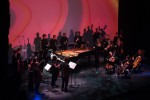One. Two. Three. Four. What’s the tempo again?
Los Angeles’ Kaleidoscope Chamber Orchestra must face the issue of synchronization without direction, because they have no conductor.
The orchestra will perform a concert at the Hammer Museum at UCLA on Thursday. Kaleidoscope’s president and UCLA alumnus Benjamin Mitchell runs the orchestra and said his goal was to facilitate an open-minded collaboration between musicians. The unconventional orchestra frequently performs free concerts at local venues, featuring classics as well as more recent music from Los Angeles composers. While performing without a conductor has brought its challenges, Mitchell said, the group has managed to bypass these issues by emphasizing the importance of inclusivity and unity.
“Our goal is to create an orchestra where everyone works together in a democratic, collaborative way,” Mitchell said. “Everyone gets a say.”
Kaleidoscope’s method comes in contrast to the typical monarchical orchestra with one conductor who calls the shots. In a normal orchestra, if a musician were to raise their hand or object in any way to the conductor’s orders, they could be fired, said Kaleidoscope violinist Alex Granger. Kaleidoscope’s collaborative process encourages everyone to share and values their input equally, Granger said.
However, this style of performance raises apprehension among others outside of the group, Granger said. Musicians often doubt the plausibility of Kaleidoscope’s structure because of its atypicality and lack of tempo instruction.
“The status quo is always an obstacle when you’re trying to do something that’s never been done before,” Granger said. “Not everyone believes in this mission.”
Some student musicians are among those who disbelieve. Christian Israelian, a former president of Whittier Area Youth Orchestra, said the ability to perform without someone directing the group seems unrealistic. The first-year public affairs and political science student said the conductor is the focal point of every orchestra.
“(Performing without a conductor) is impossible. I look to the conductor for everything,” Israelian said. “How am I supposed to keep time?”
Yet timing is not a problem for Kaleidoscope. In fact, it was an obstacle that opened doors for them to communicate through nonverbal cues, such as body language and eye contact, Mitchell said. The musicians will sometimes imagine smaller notes within the notes to better keep time, Granger said.
“Instead of looking to the conductor, we communicate with each other through motion, sound and visuals during rehearsal and performance,” Granger said. “It’s like learning a new language.”
Kaleidoscope’s setup also leads to performances that are less self-focused, he said. Each member has to learn each others’ parts – not just their own. The orchestra is thus more of a team sport, rather than a composition of individuals playing at the same time, Mitchell said.
Many orchestras use a system of seats to indicate skill. For example, the first chair player is typically more proficient than the second chair. But musicians in Kaleidoscope rotate seats, eliminating the hierarchical traits that come with them. Israelian said the lack of a first chair seems counterintuitive to the democratic organization of Kaleidoscope; he believes there will always be some element of status in an orchestra, even if the labels aren’t there.
Granger, on the other hand, said musicians appreciate the autonomy Kaleidoscope allows.
Kaleidoscope’s financial structure mirrors the egalitarian spirit the group adheres to. All of their concerts and events are free or donation-based, Mitchell said – everyone is welcome, eliminating price discrimination. Ultimately, Kaleidoscope aims to exude an essence of equality in every concert, Mitchell said.
“It’s really all about sharing,” Mitchell said. “Everyone brings something new to the table, so a little bit of everyone is reflected in our music.”
